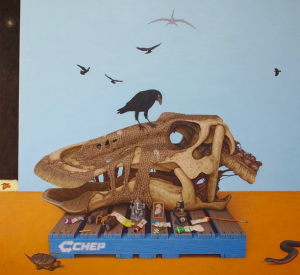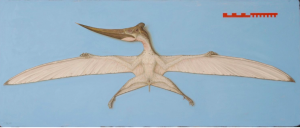All children seem to be mad about dinosaurs, many of us never outgrowing that fascination. Dinosaur exhibitions are among the best attended events at international museums, while there have been five films in the Jurassic Park franchise since 1990, with another in the pipeline. Anyone requiring a dinosaur hit over the holidays might consider a trip to Maitland Regional Art Gallery where Andrew Sullivan has a show called Survey into the Cretaceous. It’s one of several attractions at the MRAG, including Fieldwork, a travelling exhibition of Federation era Australian landscape painting from the Art Gallery of NSW (until 7 Feb), and a survey of works by Ken Done, from 2000-2017 (until 21 Feb.).
Sullivan is probably the unluckiest artist who ever got involved with the Archibald Prize. While painters such as Jenny Sages or Jiawei Shen have had portraits included in the show on numerous occasions without ever securing a win, Sullivan has been rejected year after year

Against one Archibald inclusion in 2003 he has made no fewer than 16 appearances in the Salon des Refusés. If the Trustees of the AGNSW were reliable judges of art one would have to conclude that Sullivan was a hopeless painter – but they’re not, and he’s not. One look at this work reveals a talented artist who strives to inject wit and intellectual depth into canvases produced with a painstaking realist technique.
Sullivan’s conscientiousness may be part of the problem. Looking at one of the graduate shows recently I was dismayed by the volume of works that were aimless, shapeless, and generally de-skilled. It seems we’re entering another of those mini-dark-ages when fundamental skills such as drawing are devalued, being viewed as an unbearable stricture on the free flow of creative energy. By now we should have realised this free flow almost always results in an aesthetic omelette. Having succumbed to this philosophy many graduates may eventually feel cheated by 3-4 years at college from which they have emerged with nothing more than an attitude. Some will enroll at Julian Ashton’s to learn how to draw.
Careful drawing is the basis of Sullivan’s work even if this is a crime against fashion. Another offence may be his willingness to cover a canvas with small symbols and narrative fragments, inviting viewers to find large, underlying themes in a portrait or still life. A final sin is that he has a sense of humour.

The premise of Survey into the Cretaceous is that Sullivan has been the artist for a survey team exploring the Late Cretaceous Period, which came to an end 66 million years ago. He’s a little short of detail in explaining how he scored this remarkable appointment but he has lugged plenty of specimens back to the studio for further study.
There are numerous images of prehistoric fish and flying creatures made in the manner of natural history illustrations, although without a methodical scientific approach. The representative image for the exhibition (it won him the Sulman Prize in 2014 and has been made into a jigsaw puzzle!) is the head of a Tyrannosaurus Rex displayed on a table, its jaws propped open with a stick. The back of the head has been draped in a blue-and-white tablecloth. On the table in front of the T-Rex are a lot of half-squeezed paint tubes and other bric-à-brac. Look closely at the monster’s eye and you’ll see a tiny reflection of the artist – a cute way of adding a signature that is repeated in other works.

Sullivan has amused himself by combining these precisely painted renditions of long-dead reptiles with equally accurate renderings of plastic milk crates, bottles of turps, brushes and old paint tins, along with more culturally-charged items. In Out of Purgatory he presents us with the skull of a dinosaur known as Diabloceratops; a tiny animal called Purgatorius that resembles a rodent; and a plaster bust of Dante. Although Purgatorius got its name when its bones were unearthed at a place called Purgatory Hill in Montana, Sullivan couldn’t resist the reference to Dante, who visited Purgatory in the second cantiche of The Divine Comedy. He even leaves a compass on the table top to assist with the poet’s journey.
Sullivan may be opening himself to the accusation of being too-clever-by-half, but as if to prove that his interest in Dante is genuine he copies a postcard of Botticelli’s posthumous portrait of the poet onto a work called Studio Wall (Mind’s Journey); and slips another portrait into Purgatorius’ Journey – a painting of a paint-smeared leather satchel. Presumably he’d like us to believe the rodent travelled back from the Cretaceous era in this bag.
These “wall” pictures which depict a range of postcards and diverse items attached to a flat surface are reminiscent of the trompe-l’œil still lifes of the 19th century American artist, William Harnett (1848-92), who would paint a wall or a shelf displaying a musical instrument, sheet music, a key, various tools and ornaments. It’s a way of telling a story by means of objects, or creating an oblique portrait of someone by looking at their possessions and sources of inspiration.

The most obvious pictorial allegory in the show is A Survey into the Cretaceous (Art, Science, Knowledge and Wisdom), which features a crow perched on a dinosaur skull from which shards of skin still dangle. On the same wooden palette that holds the skull we find paint tubes, binoculars, a microscope, a portrait of Charles Darwin and a statuette of the elephant God, Ganesha. The arrangement is flanked by a tortoise and a snake. The backdrop is a pale blue panel that acts like a fake window onto the sky, complete with various birds and an extinct, long-necked Pteranodon.
There’s a huge amount of information in this picture for those ready to puzzle it out, although Sullivan may be showing too much confidence in his audience. The ideal viewers of these dinosaur fantasies are children, who have a greater capacity to become absorbed in unusual details. Or at least they used to have this capacity before they became attached to the electronic screen. Interestingly, studies have shown that children who are keen on dinosaurs tend to have longer attention spans and better learning skills.
There can be few among us that don’t feel a twinge of nostalgia for the dinosaur mania so prevalent in childhood, but Sullivan intends us to look forward as well as back. If those gigantic lizards could lose their empire to a climate catastrophe we need to think seriously about our own options for the future.
Andrew Sullivan: Survey into the Cretaceous
Maitland Regional Art Gallery, 20 November, 2020 – 7 March, 2021
Published in the Sydney Morning Herald, 9 January, 2021

